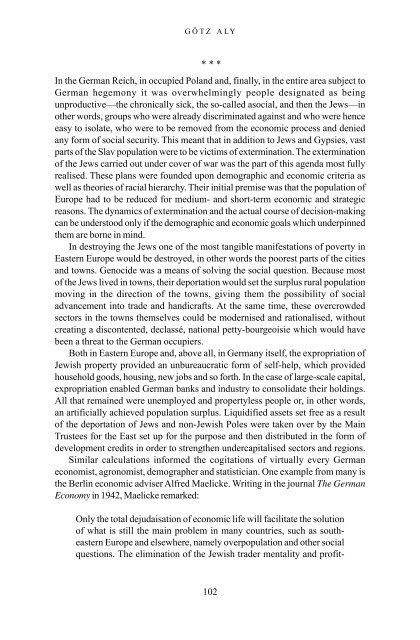The_Holokaust_-_origins,_implementation,_aftermath
The_Holokaust_-_origins,_implementation,_aftermath
The_Holokaust_-_origins,_implementation,_aftermath
You also want an ePaper? Increase the reach of your titles
YUMPU automatically turns print PDFs into web optimized ePapers that Google loves.
GÖTZ ALY<br />
* * *<br />
In the German Reich, in occupied Poland and, finally, in the entire area subject to<br />
German hegemony it was overwhelmingly people designated as being<br />
unproductive—the chronically sick, the so-called asocial, and then the Jews—in<br />
other words, groups who were already discriminated against and who were hence<br />
easy to isolate, who were to be removed from the economic process and denied<br />
any form of social security. This meant that in addition to Jews and Gypsies, vast<br />
parts of the Slav population were to be victims of extermination. <strong>The</strong> extermination<br />
of the Jews carried out under cover of war was the part of this agenda most fully<br />
realised. <strong>The</strong>se plans were founded upon demographic and economic criteria as<br />
well as theories of racial hierarchy. <strong>The</strong>ir initial premise was that the population of<br />
Europe had to be reduced for medium- and short-term economic and strategic<br />
reasons. <strong>The</strong> dynamics of extermination and the actual course of decision-making<br />
can be understood only if the demographic and economic goals which underpinned<br />
them are borne in mind.<br />
In destroying the Jews one of the most tangible manifestations of poverty in<br />
Eastern Europe would be destroyed, in other words the poorest parts of the cities<br />
and towns. Genocide was a means of solving the social question. Because most<br />
of the Jews lived in towns, their deportation would set the surplus rural population<br />
moving in the direction of the towns, giving them the possibility of social<br />
advancement into trade and handicrafts. At the same time, these overcrowded<br />
sectors in the towns themselves could be modernised and rationalised, without<br />
creating a discontented, declassé, national petty-bourgeoisie which would have<br />
been a threat to the German occupiers.<br />
Both in Eastern Europe and, above all, in Germany itself, the expropriation of<br />
Jewish property provided an unbureaucratic form of self-help, which provided<br />
household goods, housing, new jobs and so forth. In the case of large-scale capital,<br />
expropriation enabled German banks and industry to consolidate their holdings.<br />
All that remained were unemployed and propertyless people or, in other words,<br />
an artificially achieved population surplus. Liquidified assets set free as a result<br />
of the deportation of Jews and non-Jewish Poles were taken over by the Main<br />
Trustees for the East set up for the purpose and then distributed in the form of<br />
development credits in order to strengthen undercapitalised sectors and regions.<br />
Similar calculations informed the cogitations of virtually every German<br />
economist, agronomist, demographer and statistician. One example from many is<br />
the Berlin economic adviser Alfred Maelicke. Writing in the journal <strong>The</strong> German<br />
Economy in 1942, Maelicke remarked:<br />
Only the total dejudaisation of economic life will facilitate the solution<br />
of what is still the main problem in many countries, such as southeastern<br />
Europe and elsewhere, namely overpopulation and other social<br />
questions. <strong>The</strong> elimination of the Jewish trader mentality and profit-<br />
102



